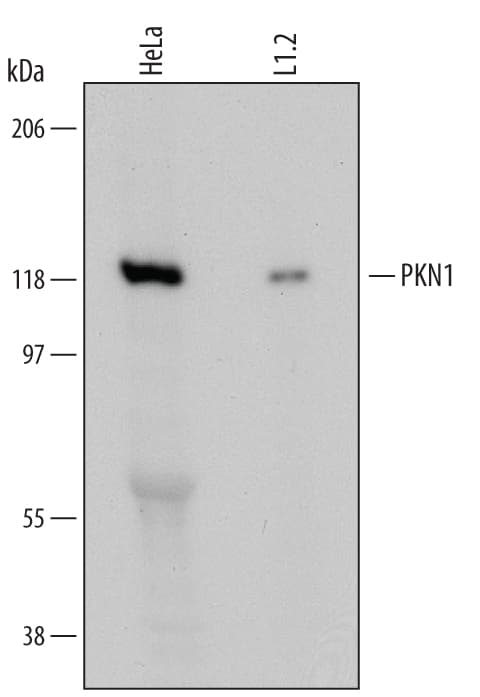 全部商品分类
全部商品分类



Ile215-Thr388
Accession # Q16512


Scientific Data
 View Larger
View LargerDetection of Human and Mouse PKN1 by Western Blot. Western blot shows lysates of HeLa human cervical epithelial carcinoma cell line and L1.2 mouse pro-B cell line. PVDF Membrane was probed with 1 µg/mL of Mouse Anti-Human/Mouse PKN1 Monoclonal Antibody (Catalog # MAB6100) followed by HRP-conjugated Anti-Mouse IgG Secondary Antibody (Catalog # HAF007). A specific band was detected for PKN1 at approximately 120 kDa (as indicated). This experiment was conducted under reducing conditions and using Immunoblot Buffer Group 1.
Human/Mouse PKN1 Antibody Summary
Ile215-Thr388
Accession # Q16512
Applications
Please Note: Optimal dilutions should be determined by each laboratory for each application. General Protocols are available in the Technical Information section on our website.



Background: PKN1
PKN1 (serine/threonine protein kinase N1), also known as PKN or PRK, is a ubiquitous 120 kDa cytoplasmic kinase of the PKC superfamily. The 942 amino acid (aa) PKN1 contains three HR1 repeats (aa 34‑263), a C2 domain (aa 325‑461), and a protein kinase domain (aa 615‑874). PKN1 can be activated by proteolysis, lipid interaction, or Rho G proteins, and is a downstream effector of RhoA. It promotes the activation of several kinases involved in regulation of the actin cytoskeleton, cell cycle, and apoptosis. In vivo, PKN1 phosphorylates histone H3 at the Thr11 position.


Preparation and Storage
- 12 months from date of receipt, -20 to -70 °C as supplied.
- 1 month, 2 to 8 °C under sterile conditions after reconstitution.
- 6 months, -20 to -70 °C under sterile conditions after reconstitution.
参考图片
Detection of Human and Mouse PKN1 by Western Blot. Western blot shows lysates of HeLa human cervical epithelial carcinoma cell line and L1.2 mouse pro-B cell line. PVDF Membrane was probed with 1 µg/mL of Mouse Anti-Human/Mouse PKN1 Monoclonal Antibody (Catalog # MAB6100) followed by HRP-conjugated Anti-Mouse IgG Secondary Antibody (Catalog # HAF007). A specific band was detected for PKN1 at approximately 120 kDa (as indicated). This experiment was conducted under reducing conditions and using Immunoblot Buffer Group 1.







 用小程序,查商品更便捷
用小程序,查商品更便捷




